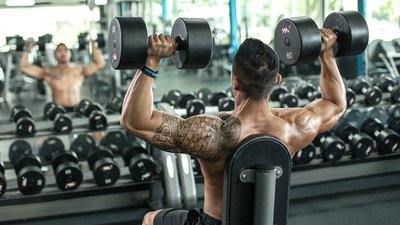If you think shoulder day is just like any other in the gym, you couldn't be more wrong. Your shoulder is a very special joint, and it deserves special treatment. Thanks to its placement, ball-and-socket structure, and freedom of movement, the shoulder is involved in just about every upper-body movement. As a result, it's subject to more wear and tear over time than probably any other joint in your body.
When training shoulders, you therefore have to consider exercises and techniques to build muscle and keep the joint healthy for the long haul. I'm all for advice that's geared toward growing your delts, but I'd be remiss if I didn't also help you minimize cumulative damage to the shoulder joint and rotator cuff along the way.
Because there's one thing I can guarantee: You can't build huge delts if you're nursing a chronic shoulder injury. So, sit up straight and pay attention to the nine most underrated shoulder tips that'll do more than just help you build size—they'll help keep your joints healthy, too!
1. Take Your Heavy Overhead Presses To The Front
Overhead press exercises—dumbbell press, barbell press, behind-the-neck press, and many other variations—may seem fairly interchangeable, but they're actually quite different.
For one thing, they don't all work the shoulder musculature in the same way. Consider when you lower a barbell behind your head or do dumbbell presses. In both moves, your upper arms go straight out to your sides. That's an indication that your middle delt is positioned to undergo maximal contraction. But when you do Arnold presses or barbell presses in front of your head, your elbows are pulled forward. As your elbows move more to the front, the anterior delts play a greater role.
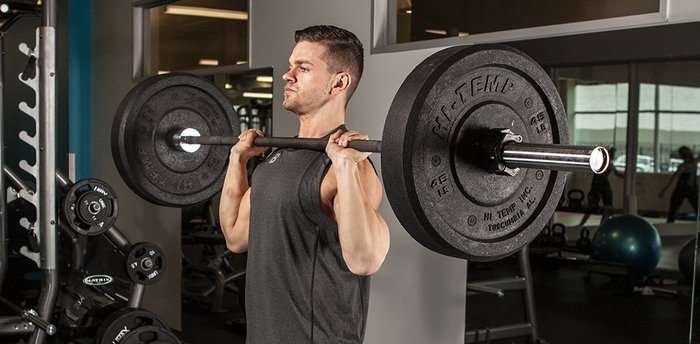
You can perform moderate-weight sets for reps behind your head, but when training with very heavy weights, keep the movement in front.
But this tip relates specifically to heavy presses, and that brings up the second point: "In the bottom position of the shoulder press with the barbell behind your head, the shoulder muscles are in their weakest anatomical position, and going heavy significantly increases the risk of a tear," says amateur bodybuilder and sports-medicine doctor Guillermo Escalante, DSc, ATC, CSCS.
In other words, when lifting heavy, taking the bar behind your head increases your risk of injury and damage. Your takeaway? You can perform moderate-weight sets for reps behind your head, but when training with very heavy weights, keep the movement in front.
2. Try Shoulder-Friendly Overhead-Press Variations
If you've already got shoulder pain—as many long-time lifters do—overhead presses may be a contributing factor. That's because the arm position reduces space in the joint and causes structures to rub against one another, a process that can lead to fraying and inflammation over time. For those who find overhead presses difficult, or even individuals who are pain-free, consider rotating shoulder-friendly versions of the overhead press into your workouts.
Nick Tumminello, owner of Fort Lauderdale, Florida-based Performance University, recommends the landmine pressas a much healthier option to rotate into your delt workouts. "The angled press allows the shoulder to follow a more natural arc, making it a more comfortable variation of the shoulder press, even for individuals who have shoulder problems," he says.
If you're currently experiencing shoulder pain, stop all exercises that aggravate it. See a sports-medicine specialist first to diagnose any underlying problems.
3. Never Extend Your Elbows During Single-Joint Shoulder Exercises
Fully extending the elbows is a beginner's mistake far too many intermediate lifters still make, especially with single-joint movements for the middle and rear delts. It's best to keep your elbows locked in a slightly bent position during moves like lateral raises and rear-delt flyes. Locking your elbow in place ensures that the only joint in motion is the shoulder, which is what you want since these are single-joint exercises.
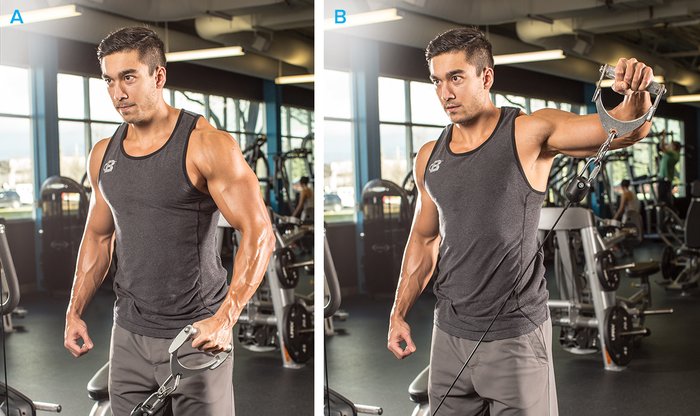
Start paying attention to what your elbows are doing during a motion. To minimize the triceps, lock a very slight bend in your elbows and hold it throughout the entire set.
However, once you start closing and opening up at the elbows, the triceps become part of the equation, reducing the effectiveness of the isolation you're trying to achieve (and turning the movement into a multijoint one). On movements like cable lateral raises and standing reverse cable flyes, many lifters mistakenly completely extend their elbows to 180 degrees at the end of the movement, then close them to about 90 degrees as they lower the weights. That's great if you're training triceps, but not great for shoulders.
Start paying attention to what your elbows are doing during a motion. To minimize the triceps, lock a very slight bend in your elbows and hold it throughout the entire set.
4. Don't Go Too Close On Upright Rows
Upright rows are a versatile multijoint exercise for delts that particularly target the middle head, but trainees typically get tripped up when it comes to hand position.
If you paid attention to the first point I made, you can figure out that to work your middle delts maximally, you want your upper arms moving directly out to your sides. That happens when you take a moderate grip on a bar when doing upright rows.
If you take a close grip on the bar, your elbows move forward and out to your sides, not directly out. That causes internal shoulder rotation, which isn't healthy for your joints. So not only do you get less emphasis on the middle delts, you also increase the likelihood of contributing to long-term shoulder damage.

5. Watch Your Overall Volume
High-volume training is a cornerstone of bodybuilding, but the math adds up fast for one set of joints that takes plenty of abuse during training for almost all upper body parts. For example, the anterior delts are heavily recruited in chest movements, especially incline presses. Multijoint exercises for the triceps also engage the shoulder joint. And on back day, the rear delts are involved in rowing motions.
All that extra work means the delts can easily be overtrained, depending on how you arrange your training split and how much volume you include on delt day.
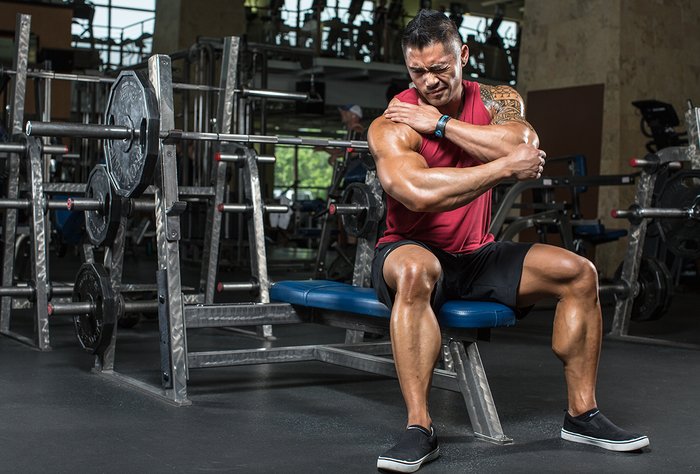
High-volume workouts may not only adversely affect delt growth by contributing to overtraining, but can sooner or later take a toll on your shoulder joint.
When it comes to your split, you can train chest and/or triceps the same day as delts. If not, you'll want to insert at least two days before or after you hit shoulders to guard against the delts being overworked on consecutive days. Worst-case scenario is training chest on Mondays, shoulders on Tuesdays, and triceps on Wednesdays. See how your delts can get worked on all three days with no rest built in?
High-volume workouts may not only adversely affect delt growth by contributing to overtraining, but can sooner or later take a toll on your shoulder joint. Occasionally cycling off to lower-volume training may save your shoulders and work as an effective strategy for growth.
6. Consider Training Rear Delts With Back
While chest day means extra work for your anterior delts, when it comes to back training the rear delts take up a greater share of the workload. That's because all those rowing motions recruit the rears to help pull your elbows back. Here, the rear delts are a secondary muscle group, but make no mistake, they're hard at work.
That's why many bodybuilders do rear-delt exercises with their back training. If so, you might consider reducing the amount of work on the posterior delts on shoulder day, especially if you train those muscle groups on consecutive days.
7. Address Weak Areas By Rearranging Your Workout
Though your delts comprise three heads—the front, middle, and rear—doing one single-joint exercise for each doesnot ensure balanced development. For one thing, your overhead presses, as noted, don't target each head equally, and most presses notably under-stimulate the rears.
Moreover, guys who focus on building a big chest may have well-developed anterior deltoids, which contribute in all chest-pressing motions. If you've neglected back training, your rear delts are probably small in comparison, which not only is apparent in the mirror, but sets you up for possible rotator-cuff complications down the road. It may also cause your shoulders to pull noticeably forward, giving you a slouched appearance.
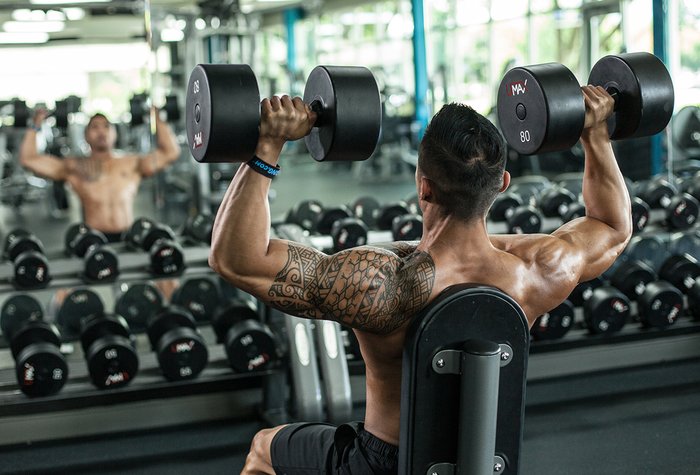
Depending on your particular circumstances, you may need to bring up one or more of your delt heads. Start by choosing a version of the overhead press that best targets it.
Depending on your particular circumstances, you may need to bring up one or more of your delt heads. Start by choosing a version of the overhead press that best targets it. Then, as you begin single-joint exercises for delts, start with the one that targets your weak area first, possibly even doing a second exercise for the lagging region.
If your delts are fairly evenly developed, you can rotate the order in which you train single-joint exercises from one workout to the next to ensure balanced development.
8. Understand The Role Of The Rotator Cuff In Upper-Body Training
While building huge shoulders is a noble goal, you can't neglect the role of the rotator-cuff muscles. While those smaller muscles and their tendons aren't visible, they help stabilize the shoulder joint.
When you train your delts and they become stronger, the ratio of the strength between the two muscle groups can become out of balance, and that increases your risk of a rotator-cuff injury. That's one reason you hear recommendations to do internal and external rotation work, which can keep your shoulders healthy for the long term.
Just standing and waving a dumbbell is a swing and a miss. Rotation work should instead be done with a cable that runs straight across your body. If you choose to use a dumbbell, lie down so that you're properly working against gravity.
9. Train Upper Traps With Shoulders
There's a good deal of shoulder elevation going on when you train shoulders, especially when doing lateral raises and upright rows. That means the upper traps are contributing to those movements. It makes sense, then, that you add some single-joint movements like shrugs to give your traps the load and volume necessary to induce growth.
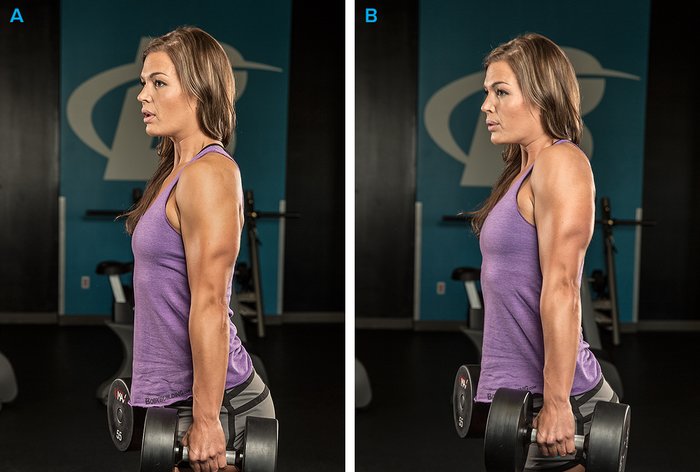
It makes sense that you should add some single-joint movements like shrugs to give your traps the load and volume necessary to induce growth.
The trapezius muscle, however, has a middle and lower portion too, and those don't get near the degree of muscle stimulation on shoulder day. Those areas are best targeted with rows and pull-downs, the kinds of exercises you train with back.
It's not uncommon to see bodybuilders combine upper traps with shoulders and leave the remainder of the traps for back day, a solid strategy you can adopt in your training.




